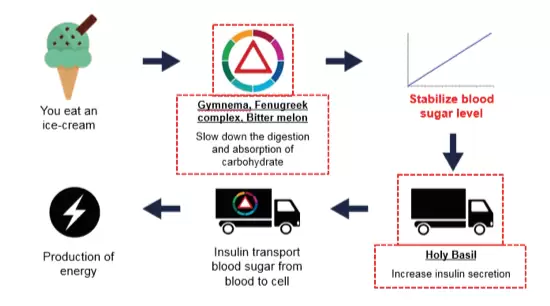
Soothe Diabetes with Natural Herbs
Dec 12, 2017
Introduction
World Diabetes Day falls every year on November 14 to raise the awareness on diabetes and its complications. It was formed by International Diabetes Federation and the World Health Organization in 1991 in response to growing concerns about the escalating health threat posed by diabetes1. In fact, diabetes is considered as one of the major public health problems in Malaysia. Statistic has shown that 1 out of every 5 Malaysians aged 30 and above are suffering from diabetes2.
This year, World Diabetes Day is focusing on women and diabetes, with the theme “Our Right to A Healthy Future”. Globally, there are 1 in 10 women is living with diabetes and many of them have limited access to education and proper treatment. Can you imagine, what will happen to diabetes sufferers without acknowledgement? The uncontrolled diabetes will get worsen and they will be potentially at risk of dying from diabetes complications such as renal and liver failures.
What is the reading of your blood sugar level? Typically, a normal fasting blood sugar level is ≤ 5.5 mmol/L3. If fasting blood sugar falls between the range of 5.6 to 6.9 mmol/L, this indicates that you are having impaired glucose tolerance3. Whereas, if fasting blood sugar level is > 7.0 mmol/L, it is suspected to have diabetes3. Bear in mind that there might be slight different for the guideline used across the laboratories. Therefore, it is best to reach out to health professionals.
Gymnema and Fenugreek Complex for Lowering Blood Sugar

A unique herbal formulation containing gymnema, fenugreek, holy basil, and bitter melon is able to regulate blood sugar level among diabetics. Gymnemic acids, the active compound in gymnema possess the ability to delay the glucose absorption in the blood as the molecules are having the same molecular structure as glucose. As a result, these gymnemic acids fill the sugar receptor in the taste buds and thus reducing body’s sensing of sweet taste in mouth4. Furthermore, these gymnemic acids fill the receptor in the intestine thus prevent sugar molecules absorption and lower the blood sugar level4. Gymnema, fenugreek, and bitter melon work synergistically to slow down the digestion and absorption of sugar or carbohydrate. Meanwhile, holy basil facilitates to stimulate and increase insulin secretion by pancreas, which is vital in regulating blood sugar level.
Pycnogenol® for Diabetic Retinopathy
In Malaysia, 1 out of 3 people with diabetes are suffering from diabetic retinopathy (DR)6. The high blood sugar level in uncontrolled diabetes increase the oxidative stress thus damaging the blood vessels in the eyes. The blood vessels then become thicker, leading to poor blood circulation. Consequently, new blood vessels start to develop in order to compensate the damaged blood vessels. However, these new blood vessels are abnormal and weak. Finally, the blood vessels will rupture and leak causing retina to bleed and swell. If left untreated, these will lead to blindness.
DR can develop without showing any symptoms. So, do not wait for it to happen to see your doctor. In fact, diabetes patients need to get their eyes checked at least once a year or more regular if having higher risk factors. On top of that, diabetes patients can lower the risk of DR by taking patented Pycnogenol® French Maritime Pine Park Extract. Pycnogenol® is standardized to contain 65% of procyanidins, a member of polyphenolic compounds known as proanthocyanidin.
Five clinical studies involving more than 1200 diabetic patients have demonstrated the efficacy of Pycnogenol® in improving the vascular system of the eyes to preserve healthier eyesight8. Pycnogenol® strengthens the retinal blood vessels to prevent leakage of fluids and blood into the retina. A study demonstrated the intake of Pycnogenol® for 2 months is able to stop the worsening of retinopathy and improve visual acuity9. The efficacy of Pycnogenol® on retinopathy is due to its free radical scavenging (antioxidant), anti-inflammatory, and capillary protective activities.

Soothe Diabetes with Natural Herbs
Having diagnosed with diabetes is not the end of the world. Many diabetics are still able to survive and live longer with controlled blood sugar level. Many of them are not dying due to the disease itself but due to its complications. Adopting a healthy lifestyle is one of the main way of managing diabetes. Along with that, every diabetic should take charge of right for a healthy future. Instead of taking medication, do consider to include natural herbs to soothe diabetes and its complications!
References:
- International Diabetes Federation, 2017. World Diabetes Day. Retrieved from https://www.idf.org/our-activities/world-diabetes-day.html
- Hussein, Z., Taher, S.W., Gilcharan Singh, H.K., and Chee Siew Swee, W., 2015. Diabetes Care in Malaysia: Problems, New Models, and Solutions. Ann Glob Health., 81(6): 851-862
- Y.L.M., 2011. Read it, understand it. The Star Online. Retrieved from http://www.thestar.com.my/lifestyle/viewpoints/tell-me-about/2011/12/28/read-it-understand-it/
- , P., Singhal, R., and Kamat, M., 2007. Gymnema sylvestre: A Memoir. J Clin Biochem Nutr., 41(2): 77–81.
- Joanne Yau., W.Y., 2012. Global Prevalence and Major Risk Factors of Diabetic Retinopathy. Diabetes Care, 35(3): 556-564
- Ministry of Health Malaysia, 2011. Clinical Practice Guidelines: Screening of Diabetic Retinopathy. Retrieved from http://www.moh.gov.my/penerbitan/CPG2017/6601.pdf
- Tan., S.C., 2016. Diabetic retinopathy screening increases from 20% to 90% in KL. The Star. Retrieved from http://www.star2.com/health/wellness/2016/09/04/diabetic-retinopathy-screening-increases-from-20-to-90-in-kl/
- Schönlau, F. , Rohdewald, P., 2001. Pycnogenol for diabetic retinopathy. A review. Int Ophthalmol., 24(3):161-71.
- Spadea, L., and Balestrazzi, E., 2001. Treatment of vascular retinopathies with Pycnogenol. Phytother Res., 15(3):219-223




